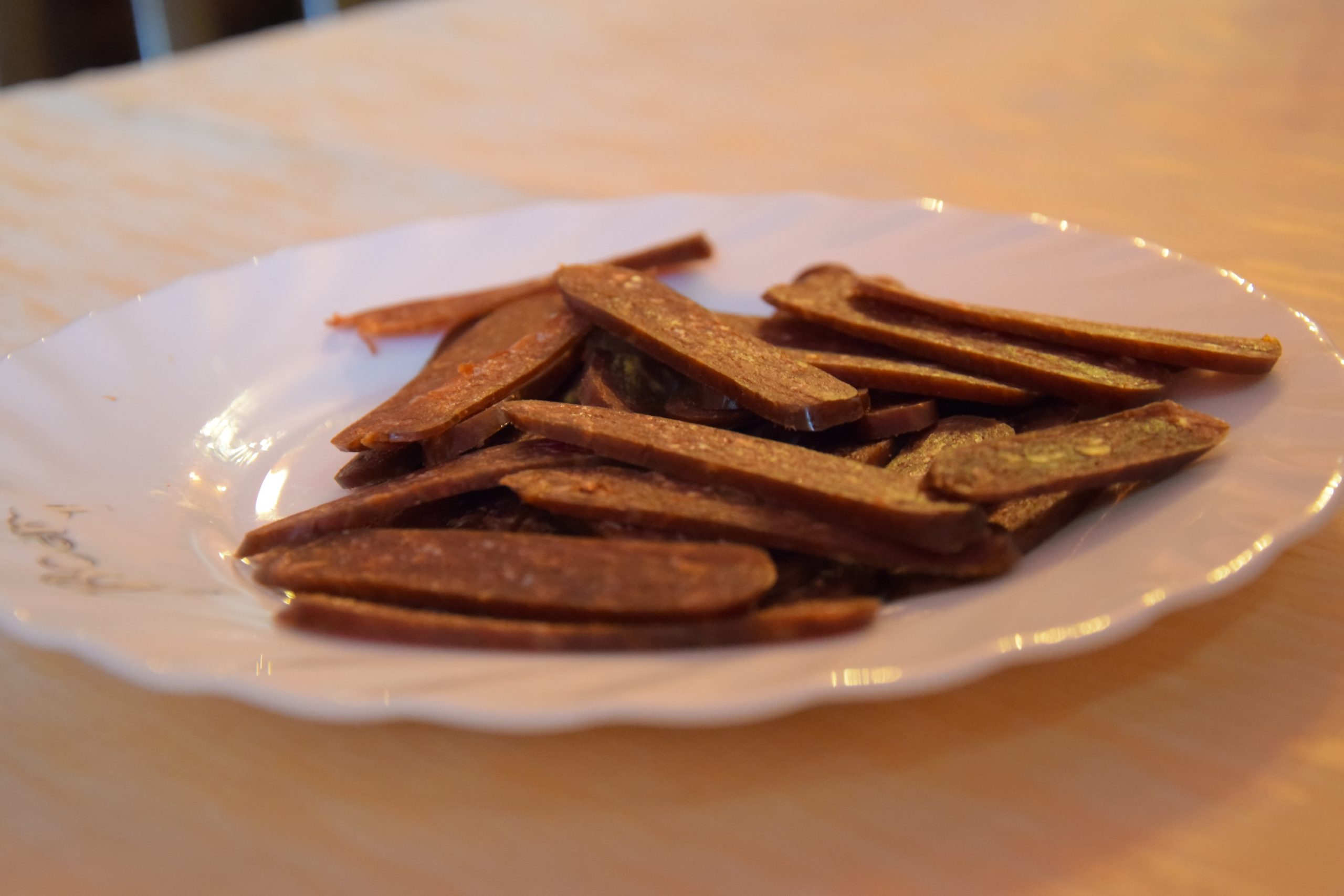Description
Ironed sausage slowly becomes the most famous gastronomic brand of Pirot, city in the region of South-eastern Serbia with specific dialect, mentality and gastronomic heritage. This dry meat product of recognizable horseshoe shape and even more recognizable taste and quality, became the symbol of skilfulness and knowledge of families and tavern owners in this beautiful town. It is made by both restaurant owners and people in the town and surrounding villages and all of them have their own way to make it and special words to praise it. While some claim that it has been made the same way for centuries, some claims it was first made after the Second World War, when new authorities banned keeping goats, so it was produce from surplus of goat meat. Traditional way of life is “responsible” for not using additives and ecological way of making it. The sausage is dried only in the wind, and is spiced only with salt, paprika, pepper and garlic. It is specific for procedure of ironing with glass bottles.
Intention
Production of ironed horseshoe sausage is unique gastronomic heritage of city of Pirot. Pirot is surrounded by Stara Planina Park of Nature which connect this region with neighbouring Bulgaria. There is different concepts of development of this area (as a mass tourism ski resort) or as a sustainable touristic destination that preserve natural resources. Promotion of traditional gastronomic heritage can be basis for sustainable tourism and economic development.
Presenting of gastronomic brands to the European neighbours is very important for solving the problem of depopulation which is one of the main problem of this underdeveloped part of Serbia. Preserving local ancient gastronomic and craftsmen tradition could be a motive for young people to stay in this beautiful part of Serbia and to present its heritage on the best way.
Presenting of Pirot’s brand Ironed sausage the European neighbours is very important because it represent the effort of local population to preserve gastronomic tradition on which they are very proud of, and in the same time to improve their economic position and contribute to the sustanible development of their community
I think that production of ironed sausage is cultural good, because it connects knowledge and skills of local population and enivironmental priciples of production at unique way. At the same time making this product popular contributes to development of tourism and stenghten local identity of Pirot citizans.
Opis
Peglana kobasica postaje najpoznatiji gastronomski brend Pirota, grada u jugoistočnoj Srbiji sa specifičnim dijalektom, mentalitetom i gastronomskim nasleđem. Ovaj suhomesnati proizvod postao je simbol umeća i znanja domaćina i ugostitelja ove lepe varoši. Proizvode je vlasnici restorana, pojedinci u gradu i okolnim selima, i svako od njih ima svoj poseban način na koji je pravi i posebne reči kojima je hvali. Dok neki tvrde da se po istom postupku pravi vekovima, drugi kažu da je nastala posle Drugog svetskog rata, kada su nove vlasti zabranile držanje koza, pa je ona proizvedena od viška kozijeg mesa. Tradicionalni način života je „odgovoran“ i za nekorišćenje aditiva i ekološki način pripreme. Kobasica se suši samo na vetru i začinjаva se samo paprikom, solju i belim lukom. Poseban je i njen način “peglanja” staklenom flašom.
Namera
Proizvodnja peglane potkovičaste kobasice je jedinstveno gastronomsko nasleđe grada Pirota. Pirot je okružen Parkom prirode Stara planina koji povezuje ovu oblast sa susednom Bugarskom. Postoje različiti koncepti razvoja ovog područja (kao velikog skijaškog centra) ili kao održive turističke destinacije kojom se čuvaju prirodni resursi. Promocija tradicionalnog gastronomskog nasleđa može da bude osnova za razvoj održivog turizma I privredni razvoj.
Prezentacija gastronomskog nasleđa susedima u Evropi je veoma važna kako bi se zaustavilo iseljavanje stanovništva koje je jedan od glavnih problema u nerazvijenim krajevima Srbije. Očuvanje drevne gastronomske I zanatske tradicije mogao bi da bude motiv mladim ljudima da ostanu u ovim lepim delovima Srbije i da predstave ovo nasleđe na najbolji mogući način.
Mislim da je proizvodnja peglane kobasice kulturno dobro jer na jedinstven način spaja znanja i umeća lokalnog stanovništva i ekološke principe proizvodnje. Istovremeno popularisanje ovog proizvoda doprinosi razvoju turizma i jačanju lokalnog identiteta Piroćanaca.
Beschreibung
Die Gebügelte Wurst wird langsam zur berühmtesten gastronomischen Marke in Pirot, einer Stadt im südöstlichen Serbien mit spezifischem Dialekt, spezifischer Mentalität und gastronomischem Kulturerbe. Dieses Trockenfleischprodukt, in erkennbarer Hufeisenform und mit besonderem Geschmack und besonderer Qualität, wurde zum Symbol von Geschicklichkeit und Wissen der Familien und Tavernen-Inhaber in dieser schönen Stadt. Das Produkt wird sowohl von Restaurantbetreibern als auch Einwohnern der Stadt und der umliegenden Dörfer hergestellt. Alle haben ihr eigenen Rezepte, um sie herzustellen, und spezielle Worte, um sie zu lobpreisen. Während manche behaupten, die Wurst wäre seit Jahrhunderten auf dieselbe Art und Weise hergestellt worden, behaupten andere, sie wäre das erste Mal nach dem Zweiten Weltkrieg hergestellt worden, nachdem neue Autoritäten das Halten von Ziegen verboten hätten und das überschüssige Ziegenfleisch verarbeitet werden musste. Die traditionelle Lebensart steht unter dem Zeichen der „Verantwortung“, sodass keine Additive verwendet werden und die Herstellung auf ökologische Weise geschieht. Die Wurst wird nur durch den Wind getrocknet und nur mit Salz, Paprika, Pfeffer und Knoblauch gewürzt. Wichtig für die Prozedur ist das spezifische Bügeln der Wurst mit Glasflaschen.
Absicht
Die Produkte der Gebügelten Hufeisenwurst sind ein einzigartiges gastronomisches Kulturerbe der Stadt Pirot. Pirot ist umgeben vom “Stara Planina Naturpark”, der die Region mit dem Nachbarland Bulgarien verbindet. In der Region gibt es verschiedene Entwicklungskonzepte, als Skiort für Massentourismus oder als nachhaltiges touristisches Reiseziel, das die natürlichen Ressourcen bewahrt. Die Förderung des traditionellen gastronomischen Kulturerbes kann die Basis für den nachhaltigen Tourismus und ökonomische Entwicklungen sein.
Den europäischen Nachbarn gastronomische Marken vorzustellen, ist sehr wichtig, um das Problem der Entvölkerung zu lösen, welches das Hauptproblem dieser unterentwickelten Region Serbiens ist. Das Bewahren von alten lokalen gastronomischen und handwerklichen Traditionen könnte für junge Leute eine Motivation dafür sein, in diesem wunderschönen serbischen Teil zu bleiben und das Kulturerbe auf beste Weise zu präsentieren.
Den europäischen Nachbarn Pirots Gebügelte Wurst vorzustellen, ist sehr wichtig, weil sie als Stellvertreterin für die Bemühungen der lokalen Bevölkerung steht, die gastronomischen Traditionen, auf die sie sehr stolz sind, zu bewahren. Und zur selben Zeit wird dadurch die ökonomische Position verbessert und ein Beitrag zur nachhaltigen Entwicklung der Gemeinschaft geleistet.
Ich denke, dass die Herstellung der Gebügelten Wurst kulturelles Gut ist, weil sie Wissen und Fertigkeiten der lokalen Bevölkerung mit Umweltprinzipien der Produktion auf eine einzigartige Weise miteinander verbindet. Und zur selben Zeit trägt das Verbreiten dieses Produktes dazu bei, den Tourismus zu fördern und die lokale Identität der Bürger Pirots zu stärken.


